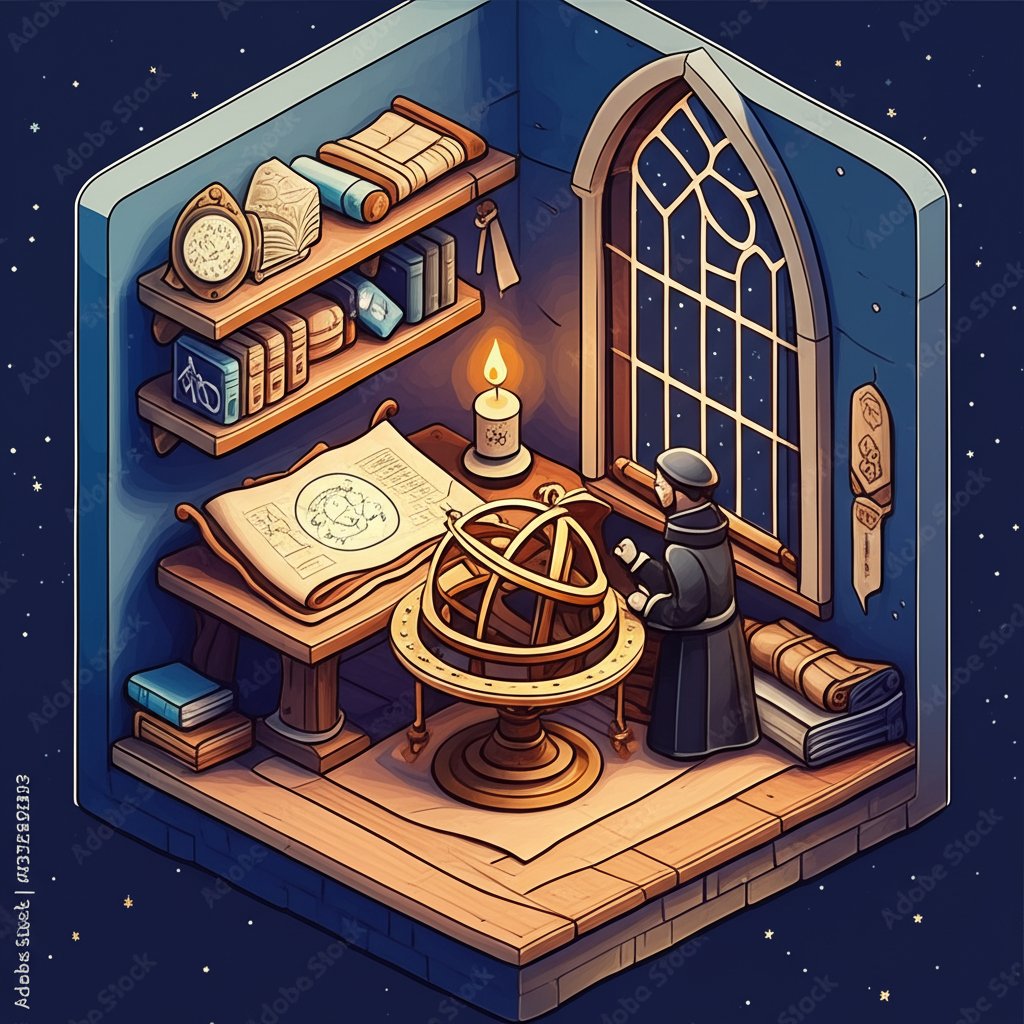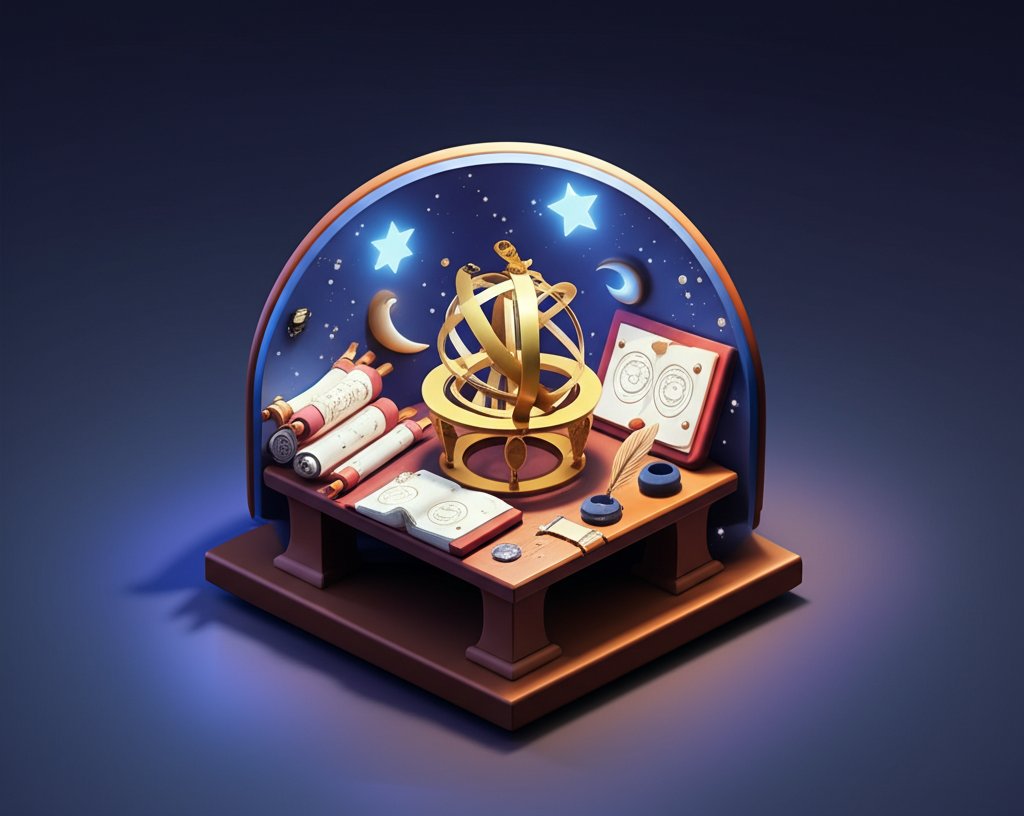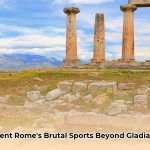Imagine gazing up at a pristine night sky, unmarred by modern light pollution, where countless stars blaze with an intensity we rarely witness today. This was the cosmic canvas for our ancestors during the Middle Ages, an era often mischaracterized as intellectually dormant. Far from being a “Dark Age,” this period was a vibrant crucible of scientific inquiry, profound spiritual contemplation, and practical innovation, particularly in the field of medieval astronomy. Driven by insatiable curiosity and a deep reverence for the celestial sphere, medieval scholars, from Baghdad to Oxford, dedicated their lives to unraveling the universe’s intricate mysteries. Their meticulous observations, sophisticated instruments, and groundbreaking theories, while sometimes rooted in beliefs vastly different from our own, laid the essential groundwork for our modern understanding of the cosmos.
This article embarks on an enlightening journey through the celestial tapestry woven by these medieval stargazers. We will delve beyond popular myths, uncover the profound contributions of diverse cultures, explore the ingenious tools they employed, and reveal the lasting wisdom that shaped their worldview and paved the way for the scientific revolution. Prepare to discover a rich and complex intellectual landscape where the movements of the heavens were believed to influence every aspect of earthly life.
Defining Medieval Astronomy: Beyond the Myths
The term “Middle Ages” often conjures images of knights, castles, and widespread superstition, leading to a misconception of intellectual stagnation. Yet, nothing could be further from the truth when it comes to medieval astronomy. This period, roughly spanning from the 5th to the 15th century, was a time of significant astronomical pursuit, marked by both the preservation of ancient knowledge and remarkable new discoveries.
A Misunderstood Era: The Pursuit of Knowledge in the Middle Ages
Contrary to popular belief, the Middle Ages were not devoid of scientific thinking. While philosophical and theological frameworks often guided inquiry, the pursuit of knowledge, particularly regarding the natural world, was deeply valued. Scholars engaged in rigorous debates, meticulous observations, and the development of complex theories. Astronomy, in particular, was considered one of the seven liberal arts (as part of the quadrivium), essential for an educated person. It was seen as the queen of the mathematical sciences, offering insights into divine order and the structure of creation.
The Scope of Celestial Study: Observation, Calculation, and Cosmology
Medieval astronomy encompassed a broad range of activities. It involved the precise observation of celestial bodies – the sun, moon, planets, and stars – to track their movements, predict eclipses, and catalogue their positions. Crucially, it also involved sophisticated mathematical calculations to model these movements, often building upon and refining ancient Greek geocentric (Earth-centered) models. Beyond mere observation, medieval thinkers developed complex cosmologies, or theories about the structure and origin of the universe, integrating their astronomical findings with philosophical and religious doctrines. This holistic approach meant astronomy was deeply intertwined with various fields, including medicine, philosophy, navigation, and religious timekeeping.
The Geocentric Universe: Ptolemy’s Enduring Influence
The prevailing cosmological model throughout the Middle Ages, both in the Islamic world and in Latin Europe, was the geocentric system developed by the Greco-Egyptian astronomer Claudius Ptolemy in the 2nd century CE, primarily described in his monumental work, the Almagest. This model posited that the Earth was the stationary center of the universe, with the moon, sun, planets, and stars revolving around it in perfect, concentric spheres. To account for the observed retrograde motion of planets (their apparent backward movement), Ptolemy introduced complex mechanisms like epicycles (small circles whose centers move along larger circles called deferents) and equants (points around which the deferent moved uniformly).
Despite its eventual overthrow by the heliocentric (sun-centered) model, Ptolemy’s system was incredibly sophisticated for its time. It provided a remarkably accurate predictive tool for celestial phenomena, allowing astronomers to calculate planetary positions for centuries. Medieval scholars dedicated immense intellectual energy to understanding, refining, and occasionally critiquing this intricate system, demonstrating a rigorous engagement with scientific principles even within a geocentric framework.
The Foundations: Greco-Roman and Early Islamic Influences
Medieval astronomy did not emerge in a vacuum; it was a vibrant continuity built upon the intellectual bedrock of earlier civilizations. The transmission and transformation of this ancient wisdom were crucial to its development.
Inheriting Ancient Wisdom: The Legacy of Greek Astronomy
The most profound influence on medieval astronomy came from ancient Greece, particularly the Hellenistic period. Beyond Ptolemy, earlier figures like Aristotle, whose cosmology posited a universe of nested, crystalline spheres, and Hipparchus, known for his early star catalogues and development of trigonometry, provided fundamental concepts. Greek texts offered a rich tradition of observational data, mathematical techniques, and theoretical models that would be studied and adapted for over a thousand years. This legacy was especially critical to the burgeoning scientific endeavors in the Islamic world.
The Vital Role of Translation: Bridging Civilizations
A pivotal turning point for the resurgence of astronomy occurred during the early Islamic Golden Age. As the Abbasid Caliphate flourished, scholars embarked on an ambitious, state-sponsored translation movement. From the 8th to the 10th centuries, countless Greek, Persian, and Indian scientific and philosophical texts were meticulously translated into Arabic. This included Ptolemy’s Almagest (known as al-Majisṭī), Euclid’s Elements, and works by Aristotle. These translations were not mere renditions; they often involved critical analysis, commentary, and the integration of new insights, making Arabic the primary language of science for centuries. This intellectual bridge was essential, as much of this ancient knowledge had been lost or fragmented in Western Europe following the collapse of the Roman Empire.
Early Christian Adaptations: Maintaining a Flickering Torch
While the Islamic world experienced a golden age of scientific inquiry, Western Europe saw a more modest preservation of astronomical knowledge during the early Middle Ages. Monasteries became crucial centers where classical texts were copied and studied. Figures like Isidore of Seville (7th century) compiled encyclopedic works, such as Etymologiae, which included sections on astronomy, preserving basic concepts of cosmology and timekeeping. Bede the Venerable (8th century) wrote treatises on calculating the date of Easter (computus), demonstrating the practical application of astronomical knowledge for religious purposes. Though less sophisticated than their Eastern counterparts, these efforts ensured that the flame of astronomical inquiry, however faint, continued to burn in Europe, awaiting the major influx of knowledge from the Islamic world.
Instruments of the Cosmos: Tools of Medieval Astronomers
The advancement of medieval astronomy was inseparable from the development and refinement of ingenious astronomical instruments. These tools allowed scholars to make increasingly precise observations, track celestial movements, and perform complex calculations, bridging theory with practical application.
The Indispensable Astrolabe: A Multipurpose Marvel
No instrument is more emblematic of medieval astronomy than the astrolabe. Originating in ancient Greece and refined significantly in the Islamic world, the astrolabe was a sophisticated analog computer capable of solving numerous astronomical problems.
Its primary functions included:
A typical planispheric astrolabe consisted of several key parts:
The astrolabe’s versatility made it an indispensable tool for astronomers, navigators, and astrologers alike, demonstrating the remarkable ingenuity of medieval craftsmanship and scientific understanding. Its widespread adoption across Europe, particularly after the 12th century, revolutionized observational practice.
Quadrants and Sundials: Simpler, Yet Essential Tools
While the astrolabe was a complex device, other instruments also played vital roles:
Armillary Spheres and Celestial Globes: Visualizing the Cosmos
For teaching and demonstrating cosmological models, medieval scholars used:
Observatories: Centers of Research and Innovation
The construction of dedicated observatories marked a significant advancement in medieval astronomy. These were not merely places for casual stargazing but sophisticated, often state-funded institutions equipped with large, permanently mounted instruments and staffed by teams of astronomers.
Prominent observatories emerged in the Islamic world, such as:
In Europe, while less grand initially, centers of learning like the University of Oxford saw the establishment of astronomical interests, with instruments like astrolabes and quadrants becoming common tools for scholars. These observatories facilitated collaborative research, standardized observations, and accumulated vast amounts of data, creating an environment primed for scientific discovery.
The Golden Age of Islamic Astronomy: A Beacon of Innovation
The Islamic Golden Age, roughly from the 8th to the 15th centuries, represents a truly transformative period for medieval astronomy. While often viewed as “preservers” of ancient knowledge, Islamic scholars were profound innovators, whose contributions were foundational for the later Scientific Revolution in Europe.
Preservation and Expansion: Beyond Mere Translation
Islamic savants did not simply translate ancient Greek, Indian, and Persian texts; they actively engaged with them. They meticulously scrutinized the works of Ptolemy, Aristotle, and others, identifying inconsistencies, correcting errors, and refining theories with remarkable intellectual rigor. This critical spirit led to a deeper understanding and a drive for improvement. Scholars like Muhammad ibn Musa al-Khwarizmi (9th century) integrated Indian numerical systems and computational methods, which dramatically simplified astronomical calculations. Al-Battani (9th-10th century) rejected some of Ptolemy’s models, introducing more accurate computations and greatly improving the precision of astronomical tables.
Mathematical Rigor and Observational Accuracy: A Scientific Leap
Islamic astronomers made significant advancements in mathematics, particularly in trigonometry and algebra, which they applied directly to celestial mechanics. They developed new trigonometric functions (sine, cosine, tangent, cotangent) and applied them to spherical geometry, essential for calculating positions on the celestial sphere.
Their observational efforts were equally impressive:
Challenging the Status Quo: The Maragheh Revolution
Perhaps the most significant, yet often overlooked, contribution of Islamic astronomy was the systematic critique of Ptolemy’s geocentric model. Scholars at observatories like Maragheh and Damascus identified serious philosophical and mathematical flaws in Ptolemy’s use of the equant, which violated the Aristotelian principle of uniform circular motion. The “Maragheh School,” spearheaded by figures like Nasir al-Din al-Tusi and his student Qutb al-Din al-Shirazi, developed alternative, non-Ptolemaic mechanisms that preserved uniform circular motion while still explaining observed planetary movements. These innovations, later adopted by Ibn al-Shatir in Damascus, represented a radical departure from the Ptolemaic system and showed an independent path toward understanding celestial mechanics, centuries before Copernicus. The transfer of these ideas to Europe, possibly through Byzantine channels, is a subject of ongoing historical debate but highlights the profound depth of Islamic intellectual inquiry.
Notable Islamic Observatories: Centers of Collaborative Excellence
The construction and elaborate staffing of observatories such as those in Baghdad, Maragheh, and Samarkand fostered an environment of collaborative scientific research. They were equipped with impressive instruments, some on a massive scale for unprecedented precision, and supported by caliphs and rulers who valued scientific pursuits. These institutions trained generations of scholars, accumulated vast libraries, and produced numerous astronomical treatises and zijes (astronomical tables), which served as indispensable reference works for calculating planetary positions, determining time, and navigating.
The innovations of Islamic astronomers were not merely incremental; they represented a fundamental shift in scientific methodology, emphasizing rigorous observation, mathematical precision, and a critical stance towards inherited knowledge. Their legacy is a testament to the power of intellectual curiosity and cross-cultural exchange in advancing human understanding of the cosmos.
Astronomy in Medieval Europe: Revival and Integration

While the Islamic world led the charge in astronomical innovation for much of the early Middle Ages, medieval astronomy in Latin Europe experienced its own significant revival, profoundly shaped by the influx of Arabic knowledge from the 12th century onwards.
The Twelfth-Century Renaissance: A Flood of Knowledge
The 12th century witnessed a transformative intellectual awakening in Europe, often termed the “Twelfth-Century Renaissance.” A critical component of this revival was the large-scale translation effort, primarily from Arabic into Latin. Centers like Toledo in Spain, Palermo in Sicily, and various points of contact between the Islamic world and Europe became conduits for an astonishing volume of scientific, philosophical, and medical texts. Among these, the translation of Ptolemy’s Almagest, along with numerous Arabic commentaries and original works by Islamic astronomers, reignited European interest in sophisticated mathematical astronomy. This influx provided European scholars with a comprehensive body of knowledge that had largely been absent for centuries.
University Scholasticism: Astronomy in the Curriculum
With the establishment and growth of universities across Europe (e.g., Paris, Oxford, Bologna), astronomy became a core component of the curriculum. It was taught as part of the quadrivium (arithmetic, geometry, music, and astronomy), the higher division of the seven liberal arts. Scholars studied Ptolemy’s Almagest and, more accessibly, Sacrobosco’s De sphaera mundi (On the Sphere of the World), a highly influential textbook that provided a basic understanding of geocentric cosmology, planetary movements, and the use of the astrolabe. This institutionalization ensured a continuous tradition of astronomical education and research.
Key European Figures and Their Contributions
Though often working within the established geocentric framework, European medieval astronomers made significant contributions:
Christian Cosmological Views: Integrating Faith and Reason
For European scholars, medieval astronomy was not seen as contradictory to Christian theology but rather as a means to understand God’s creation. The order and regularity of the heavens were often interpreted as evidence of divine design. Cosmological models were integrated into religious thought, as exemplified by Dante Alighieri’s Divine Comedy, which beautifully allegorizes the Ptolemaic universe. Debate and inquiry were encouraged, as long as they ultimately supported or did not directly contradict core theological tenets. This integration fostered a nuanced interplay between faith and reason, shaping the unique character of European medieval science.
Practical Applications: Shaping Medieval Life
Far from being an abstract academic pursuit, medieval astronomy was deeply woven into the fabric of daily life, influencing decisions from the mundane to the monumental. Its practical applications underscore its immense importance across various societal functions.
Timekeeping and Calendar Reform: Following the Celestial Rhythm
For medieval societies, accurate timekeeping was essential for agriculture, religious observances, and civic organization. Astronomy provided the means to achieve this:
Navigation and Exploration: Steering by the Stars
Before the advent of modern navigational tools, sailors relied heavily on the stars to guide them across vast oceans. Medieval astronomy was critical for:
Agriculture and Seasonal Planning: Planting by the Stars
Dependent on the rhythms of nature, medieval agrarian societies used celestial observations to optimize agricultural practices:
Medicine and Health: The Cosmic Body Connection
In medieval medicine, the human body was often seen as a microcosm reflecting the macrocosm of the universe. Astrology, deeply intertwined with astronomy, played a significant role in diagnosis and treatment:
Architecture and Art: Cosmic Inspiration
The influence of medieval astronomy extended into the visual and tangible culture of the era:
These diverse applications demonstrate that medieval astronomy was not merely an ivory tower pursuit but a dynamic, practical science that deeply informed and shaped the worldview and daily practices of medieval societies.
The Intertwined Fate of Astronomy and Astrology
To understand medieval astronomy fully, one must grapple with its inseparable, yet often contentious, relationship with astrology. For much of the Middle Ages, the two disciplines were not sharply distinguished, operating under the shared premise that the cosmos influenced earthly affairs.
Two Sides of the Same Coin? The Overlap and Gradual Divergence
Initially, in both the Islamic world and Latin Europe, the terms “astronomy” and “astrology” were often used interchangeably, or astrology was seen as the practical application of astronomical knowledge. Astronomy provided the data—the precise positions and movements of celestial bodies—while astrology interpreted the meaning and influence of this data on human lives, events, and the natural world. This ancient tradition derived from Babylonian, Hellenistic, and Indian sources.
However, as scholarly inquiry progressed, a gradual divergence began to occur, particularly among more critical thinkers. The scientific aspect (astronomy) focused on observation, mathematical modeling, and prediction of celestial phenomena, while the interpretive aspect (astrology) dealt with the supposed causal links between celestial positions and terrestrial events.
Horoscopic Astrology and its Ubiquitous Uses
Astrology permeated various levels of medieval society:
Scholarly Debates and Critiques: Early Skepticism
Despite its widespread acceptance, astrology was not without its critics. Even within the Islamic Golden Age, where astronomical advancements flourished










